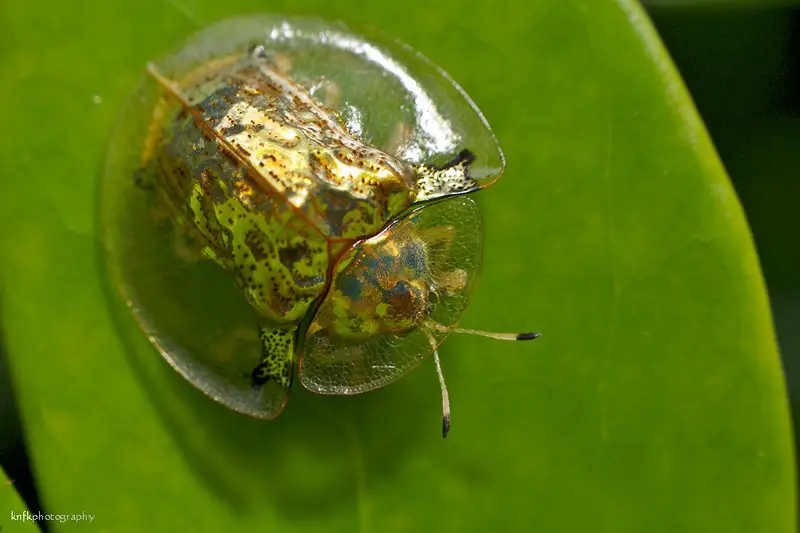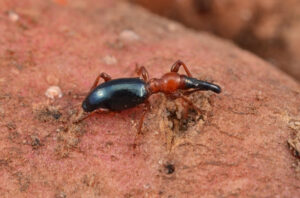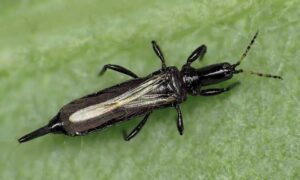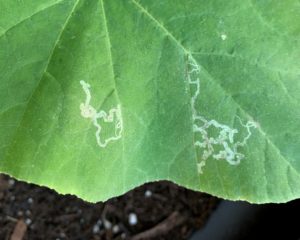Tortoise beetles are some of the most fascinating beetles in the garden. They measure a mere 5 to 7 mm (approximately 1/4″) and come in a variety of striking colors like metallic gold, rust, orange, metallic green, and metallic blue. At first glance, the metallic ones look like sequins.
These members of the leaf beetle family are located throughout the United States, Canada, Central and South America, and portions of the Caribbean Islands. Some of the more well-known varieties include the golden tortoise beetle, the mottled tortoise beetle, and the striped tortoise beetle.
Adult tortoise beetles use some unique features to protect themselves from predators. They can cover themselves with their clear pronotum and elytra, which are flanged plate-like structures that extend beyond their oval-shaped bodies. The hardened shell protects them much like a tortoise’s shell, hence the name tortoise beetle. This feature makes it difficult for predators to capture them. They can also evade predators by suddenly dropping off the leaf on which they are sitting. It is an effective “disappearing act.” Like cucumber beetles, they can also fly to safety.
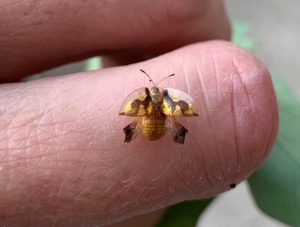
Life Cycle
In the spring, adult female golden tortoise beetles lay between ten and fifteen flat, white, oval eggs in a cluster on the underside of leaves, while green tortoise beetles lay single eggs in considerably greater numbers. The eggs take between five and ten days to hatch. The larvae immediately begin to feed on plant foliage. Their flat, oval-shaped bodies are light brown, yellow, or light green in color, and they have a spiny fringe border. When they molt, they will attach their shed exoskeletons to an anal fork (also known as a fecal fork) located on the last abdominal segment. A telescopic anus allows them to place their excrement onto the fecal fork as well. They carry the skin and excrement over them like an umbrella, and are able to angle it like a shield to protect themselves from some predators. The larvae mature in about two to three weeks, after which they will pupate before becoming a mature beetle.
The entire life cycle, from egg to adult beetle, takes approximately forty days to complete. Multiple generations are possible each year, especially in warmer climates. Adult tortoise beetles live between two and three months.
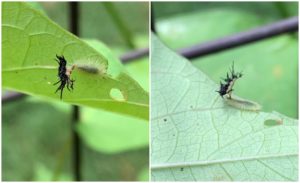
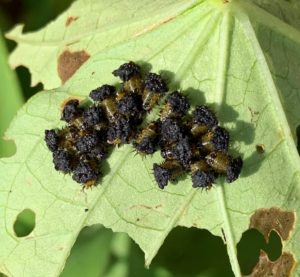
Tortoise Beetle Habitat
Tortoise beetles are found just about anywhere. Some feed on anacua trees, while others target bindweed, tomatoes, peppers, corn, milkweed, eggplant, cabbages, strawberries, zinnias, moon flowers, morning glory, and sweet potato vines.
Both adults and larvae hide on the underside of leaves and are most active in the spring and summer. They tend to live in groups, although the ones I find in my garden are usually by themselves. Adults will overwinter in leaf litter, garden debris, and under tree bark.
Quick Change Artists
Some tortoise beetles, like the golden tortoise beetle, can change their colors, not to match their surroundings, but more as a reflection of their mood. They are gold when at rest or when procreating, and change to orange with black spots or to brown with spots when stressed. A color change may also occur due to the beetle’s age, especially as it approaches the end of its lifespan. Others beetles, like the mottled tortoise beetle, do not change color except for when they are nearing the end of their lifespan, in which case they will turn a brown-red.
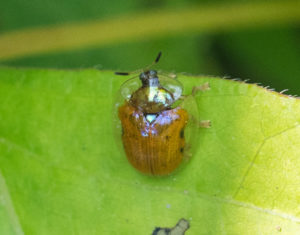
Damage
Adult beetles damage plants by chewing holes in the leaves, while larvae usually will scrape the leaf tissue without making holes. This kind of damage can be deadly for seedlings but, generally speaking, does not cause enough damage to kill mature plants. Serious infestations may, however, defoliate plants. Nevertheless, some do not consider tortoise beetles to be true pests.
Tortoise beetles are not known to be predators and will not hurt humans.
This article contains affiliate links. If you make a purchase using one of these links, I will receive a very small commission at no additional cost to you, and it will help me maintain this website. Rest assured, I only recommend products I actually like!
How to Control
One of the best ways to protect your plants from tortoise beetles is to remove the beetles by hand. In addition, you can make your garden hospitable to the beetle’s natural predators. Ladybugs, parasitic wasps, damsel bugs, stink bugs (shield bugs), and assassin bugs will target the larvae.
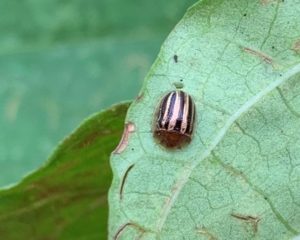
If the beetles are causing excessive damage, you can make a spray to deter them from feeding and laying eggs on your plants. Start with 1-2 teaspoons of pure, cold-pressed neem oil with the naturally occurring compound, Azadirachtin, which makes it more effective. This is the neem oil I use. Mix it with 1/2 teaspoon of a Castile soap like Dr. Bonner’s or Dr. Wood’s, and 1 quart of water in a spray bottle. Do a spray test on a leaf and wait 24 to 48 hours to see results before spraying the rest of the plant. If there is any noticeable damage to the leaf, dilute the spray and retest. Repeat once a week if necessary. Do not spray during the day as the combination of sun and oil could burn your plants. Keep in mind that the spray may also harm beneficial insects.
Healthy plants are better equipped to combat small infestations, so water well, fertilize when appropriate, and inspect plants regularly for pests.
Tortoise beetles can admittedly be an annoyance, but they are fascinating creatures.
Thank you for reading this article! If you found it helpful, please consider sharing it with others via email and on social media!
